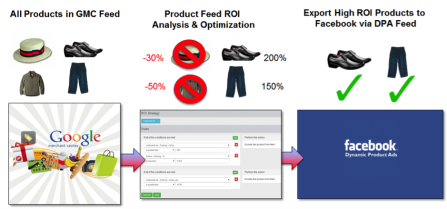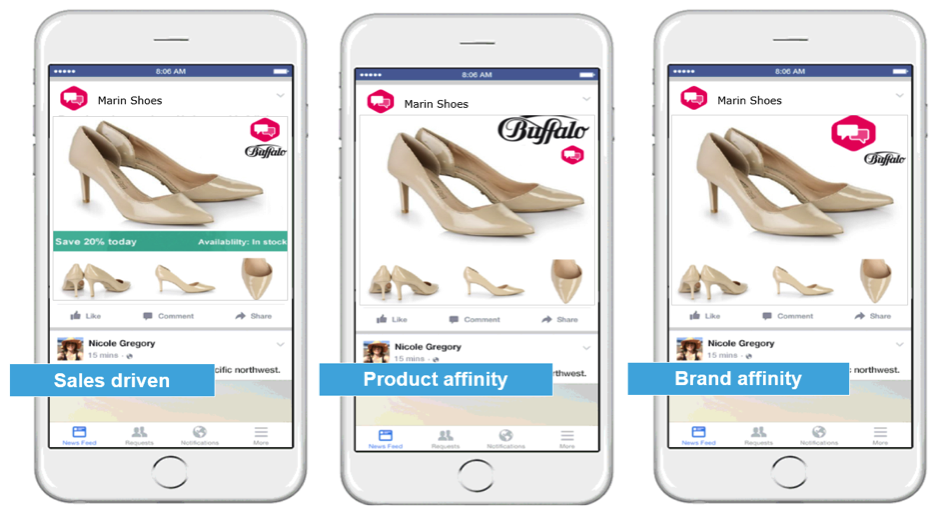When Google released dynamic product ads, it dramatically changed the way retailers advertise online. Because of their huge success, retailers are constantly on the lookout for the next game-changing ad format.
If the results our retail clients have been seeing are any indication, the next frontier for dynamic product ads is harmonizing Google Shopping and Facebook Dynamic Ads (DA). Even though there’s been steady growth in the number of advertisers using Facebook DAs since their launch in 2015, many retailers are still managing their search and social channels in silo.
In this post, you’ll learn how to supercharge your shopping ads by combining the best of search and social. Using these techniques, our customers have seen a 68% higher revenue per conversion from their search campaigns, when managed together with social advertising campaigns.
Seed Facebook with your best Google Shopping campaigns.
Savvy advertisers take advantage of their existing Google Shopping campaigns to optimize—or simply test—DAs for the first time. By identifying your best-performing products from Google Shopping campaigns, you can export high-ROI products to advertise using DAs.
Through Facebook’s new Google Shopping to DA product (available to Marin Software customers), advertisers using Google Shopping can take their best-performing campaigns and easily create Facebook DAs in a few easy steps, without the need for lengthy setup and extensive IT resources.

Build out the right types of campaigns.
To easily increase your average order value and/or customer lifetime value, be sure to offer products related to what a customer’s ordered. As you’re building out DA campaigns, you can create upsell, cross-sell, and prospecting campaigns using the same process.
- Upsell and cross-sell: With these types of campaigns, you can increase the chances of selling complimentary, relevant products to your customers via upsell (higher profitability items) or cross-sell (similar product sets).
- Prospecting: Take shopping on Facebook beyond retargeting through Facebook’s DA prospecting campaigns. Advertisers can now reach new customers within the Facebook universe who haven’t visited your website. Facebook allows you to automatically create the best ads and find the best users for prospecting, giving you an efficient, effective way to find new audiences for your products.
Use search intent data to power DA creative.
Search intent retargeting is the smartest way to maximize the ROAS of your search budget. As cross-channel marketing strategies become commonplace, digital advertisers have started using search intent data to power their social campaigns. This strategy can be extended to Facebook DAs.
One example: using search intent to optimize DA creative templates. If the right users see them, these dynamic changes to creative can lead to significant lifts in CTR, conversion rates, and ROI.
Let’s say you have three users who’ve reached your website using different levels of search intent.
Example keywords:
- Discount-driven (keyword: discount shoes)
- Product brand (keyword: Buffalo Shoes)
- Store name (keyword: PowPow Shoe Shop)
Through DA creative templates and search intent data, you can dynamically tailor your Facebook creatives based not only on the products users have seen on your website, but also on the keyword they used to get there in the first place. This allows you to show hyper-targeted ads, resulting in higher click-through and conversion rates.

In the above example, our users see different things depending on their keyword group:
- Sales-driven user (keyword: discount shoes) sees an ad with a sales message.
- The user who’s shown product brand infinity (keyword: Buffalo Shoes) sees a creative with a large product brand logo.
- The user who’s shown brand affinity for the shop/advertiser (keyword: Marin Shoe Shop) sees a large advertiser logo.
Use cross-channel product reporting and optimization.
Once you start running Google Shopping and Facebook DAs, you should look at product performance and optimization in a more holistic way. The challenge with cross-channel tracking is normalizing conversions across multiple devices, ad buys, and other variables. However, with a third-party platform like Marin Software, the problem’s solved, so you can focus on the most important task—making sense of all that rich data and finding synergies.
With consistent third-party conversion tracking, you can also deduplicate conversions across search and social. And, through attribution modeling, you can gain deeper insights into how your Google Shopping and Facebook DAs are affecting the overall path to conversion.
Your future shoppers are spending an ever-increasing amount of time on Facebook and Google. In fact, 78% of all new ads were on either Facebook or Google last quarter. Now’s the time to think smarter about how you can cost-effectively engage and convert these users.
By combining search and social shopping strategies, not only do you break down channel silos—you gain a holistic view of product performance, and the ability to optimize across channels and improve overall product performance.
Digital & Social Articles on Business 2 Community(48)
Report Post





